What is Gunkan | Best Gunkan Sushi Recipe
Bring the flavors of a Japanese restaurant to your home by mastering homemade gunkan sushi. With this step-by-step guide, you can effortlessly recreate this ship-shaped sushi, customizing ingredients to your liking. No need to dine out – enjoy restaurant-quality gunkan anytime, right in your own kitchen in less than 15 minutes.

What is Gunkan?
Gunkan, also known as “gunkan maki,” is a type of sushi that consists of a small, hand-formed oval-shaped mound of vinegared sushi rice wrapped in a strip of nori (seaweed) to create a “boat” shape. This rice “boat” is typically topped with various ingredients such as seafood, fish roe, or other flavorful items. Gunkan sushi is designed to hold ingredients that might be too loose or delicate to stay on top of traditional nigiri sushi. It allows for creative combinations and textures, making it a popular choice for sushi enthusiasts.
Gunkan sushi is usually eaten as an appetizer or side dish rather than a main dish. It’s often part of a larger sushi meal, where individuals can enjoy a variety of sushi types and flavors.
Why You’ll Love This Recipe
- Customizable: Gunkan allows for unique ingredient pairings and creative flavor combinations, appealing to adventurous eaters. The flexibility of gunkan also allows for a wide range of ingredient choices, catering to different tastes.
- Easy to make: Gunkan holds delicate ingredients securely, preventing them from falling apart, which can happen with traditional nigiri. There’s no rolling involved as with traditional hand-rolled sushi.
- Bite-Sized: Gunkan sushi is typically small and easy to eat, making it a delightful one-bite sushi experience.
- Instagram-Worthy: Its beautiful presentation and creative toppings make gunkan popular among social media food enthusiasts.
Ingredients Needed

Please scroll ⬇️ to the recipe card to see the full ingredient amounts and instructions.
- Sushi Rice: use short-grain Japanese sushi rice. Look for it at Asian grocery stores or online retailers specializing in Japanese ingredients.
- Sushi Rice Seasoning: sushi rice is seasoned with a mixture of rice vinegar, sugar, and salt. This creates the perfect balance of flavors to complement the toppings.
- Nori Seaweed Sheets: essential for wrapping the gunkan and holding the toppings in place. Cut the nori seaweed sheets into 1 1/2-inch strips. They’re available in Asian grocery stores, specialty markets, and online retailers offering a variety of sizes and qualities.
- Favorite topping of your choice: I used salmon, tuna, tobiko, and ikura. I found everything at my local Asian (Korean) grocery store. Feel free to use any topping you like. You can browse through the list below to gather ideas, whether you opt for the traditional route or experiment with different flavor combinations.
Popular Toppings

- Ikura (salmon roe): Ikura can be used in gunkan by topping rice-filled nori boats with its vibrant, salty, and popping salmon roe texture.
- Salmon: Salmon is used in gunkan by placing its tender, sliced, or cubed pieces atop rice-filled nori boats
- Tuna or fatty tuna: Both regular tuna and fatty tuna (also known as toro) can be used as toppings in gunkan sushi. Tuna is a popular choice for gunkan sushi due to its rich flavor and texture. Fatty tuna, in particular, is prized for its buttery and melt-in-the-mouth quality, making it a luxurious option for gunkan sushi toppings.
- Masago (capelin fish roe): Masago, a small orange fish roe, adds a burst of color and texture to gunkan sushi
- Tobiko (flying fish roe): Tobiko is known for its vibrant red color and mild flavor.
- Uni (sea urchin): Uni has a distinct and acquired taste. Its flavor is often described as briny, slightly sweet, and with a rich, creamy texture reminiscent of the ocean. It’s considered a delicacy in many cuisines.
- Kani (imitation crab): While traditional gunkan sushi is often topped with fish roe, seafood, or other ingredients, there’s no strict rule against using kani in gunkan. The versatility of sushi allows for various creative combinations. Mix shredded kani with sriracha mayo for a unique gunkan-style sushi.
- Goma wakame salad (seaweed salad): While Goma wakame salad (seaweed salad with sesame dressing) is typically not used as a topping in traditional gunkan sushi, sushi chefs often experiment with flavors and textures. You could potentially create a fusion-style gunkan sushi by incorporating small amounts of Goma wakame salad as a garnish or layering it with complementary ingredients.
- Vegetable toppings: make it healthy by adding diced or sliced vegetables, such as avocado, cucumber, or yamagobo, to your gunkan.
How to make it
Step One: Prepare Sushi Rice. Cook sushi rice according to package instructions. While the rice is still warm, gently mix in a mixture of rice vinegar, sugar, and salt to season it. Let it cool to room temperature.
Step Two: Cut Nori Strips. Cut nori sheets into strips slightly wider than the rice mounds you’ll be forming, about 1 1/2 inch (follow the lines).


Step Three: Shape Rice Mounds: Wet your hands to prevent sticking and take a small handful of seasoned sushi rice. Gently press and shape the rice into oval mounds using your hands. Ensure they hold their shape but aren’t overly compressed.
Step Four: Wrap with Nori. Wrap a nori strip around the rice mound, leaving a portion sticking out to form the “boat” shape. Press the nori gently against the rice to make it adhere.

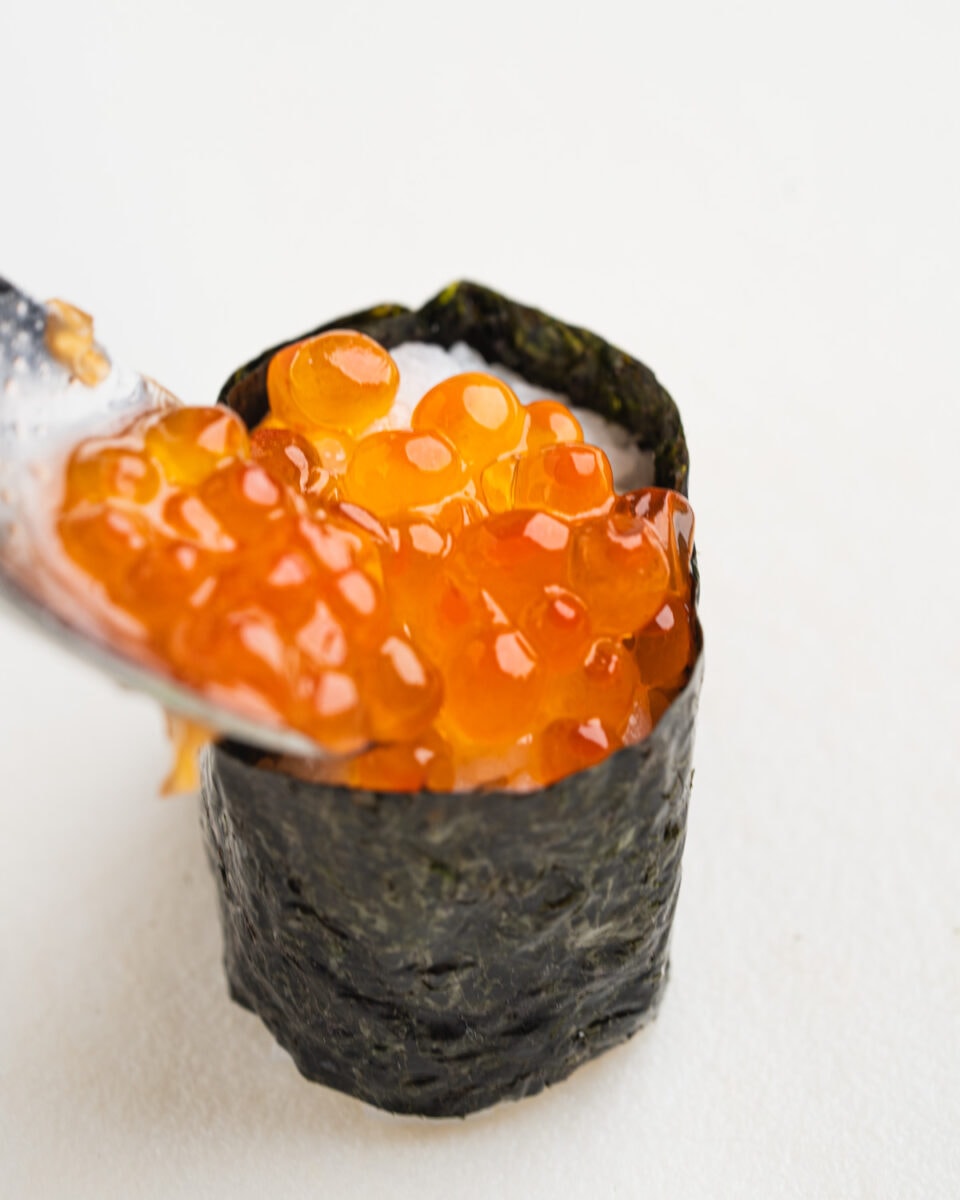
Step Five: Add Toppings. Carefully arrange your chosen toppings on top of the rice in the nori “boat.” Get creative with your combinations.
Serve and Enjoy: Arrange the gunkan sushi on a plate and serve immediately for the best taste and texture.

Helpful Tips for the Best Gunkan Maki
- Quality Ingredients: Start with fresh and high-quality ingredients, such as sushi-grade fish, seafood, and fresh nori.
- Proper Rice: Use well-cooked sushi rice seasoned with vinegar, sugar, and salt. The rice should be slightly warm when forming the gunkan.
- Nori Placement: Cut nori strips slightly wider than the rice mound. Wrap the nori strip around the rice, leaving a portion sticking out to form the “boat” shape.
- Firm Rice Mounds: Gently press and shape the rice into oval mounds using your hands. The rice should hold its shape without being too loose or too tight.
- Nori Adhesion: Make sure the nori strip adheres well to the rice by pressing it gently against the rice, ensuring it sticks but isn’t tightly compressed.
- Freshness: Serve the gunkan sushi immediately after assembly to maintain the freshness of the ingredients.
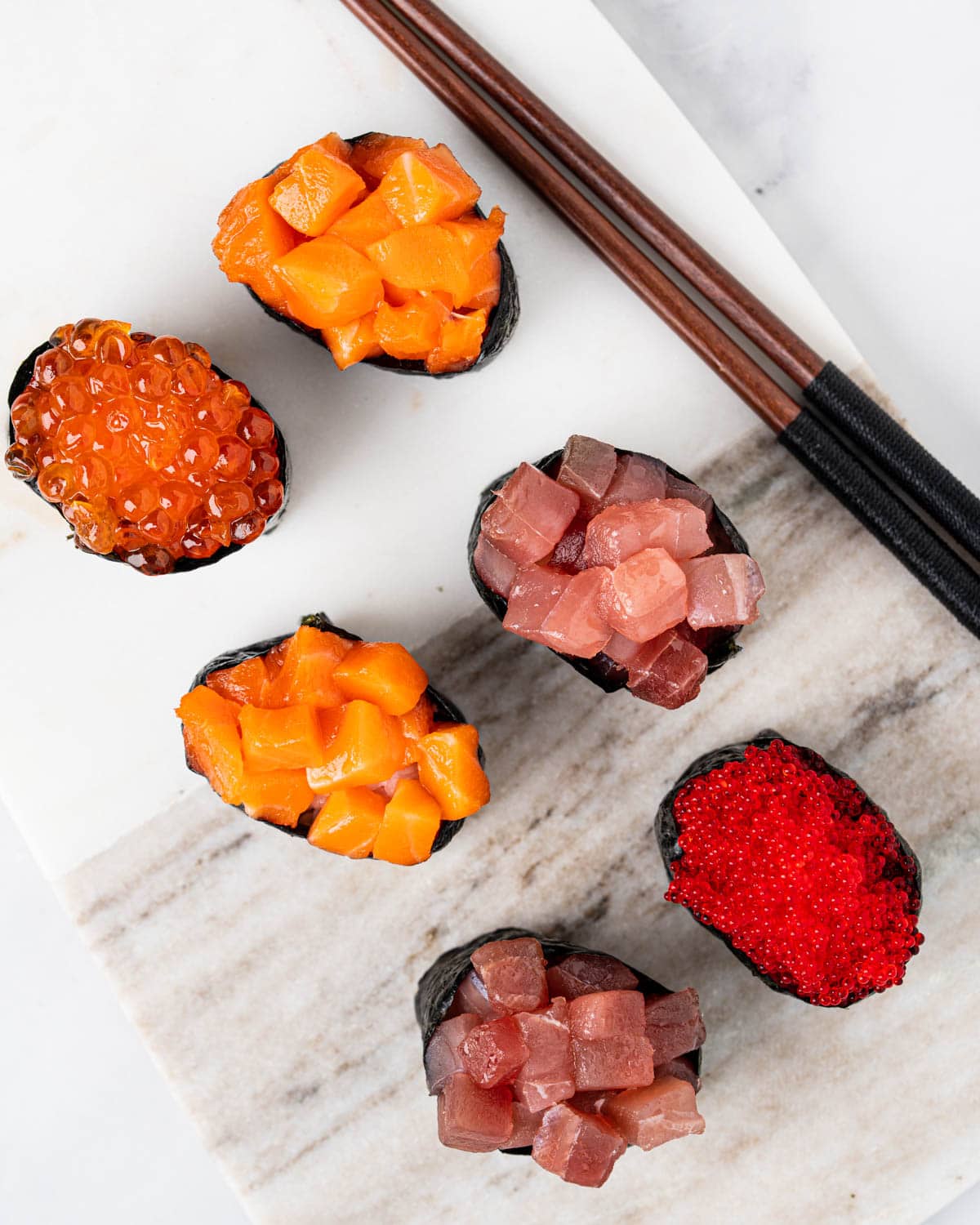
Frequently Asked Questions
Gunkan sushi typically consists of bite-sized “boats” made from seasoned sushi rice wrapped in a strip of nori (seaweed). These rice boats are then topped with various ingredients, which can include seafood such as fish slices (like tuna, salmon), sashimi-grade seafood (like sea urchin or octopus), fish roe (like masago or tobiko), or even non-seafood options like avocado or other creative fillings. The toppings are often chosen for their taste, texture, and visual appeal. Gunkan sushi offers a canvas for diverse and delicious flavor combinations.
“Gunkan” is a Japanese term that translates to “warship” in English. The name “gunkan” for this type of sushi originates from its appearance – the small, hand-formed rice mound wrapped in nori resembles a warship with its “hull.” This unique shape was designed to hold loose or delicate toppings like fish roe that might not stay on traditional nigiri sushi. The name reflects the creative and practical nature of this sushi style, as it serves as a vessel to hold a variety of flavorful toppings.
Gunkan sushi can be made with both raw and cooked ingredients, depending on the choice of toppings. While some gunkan sushi variations feature raw seafood like fish slices or sea urchin (uni), others may include cooked or smoked seafood, fish roe, or even non-seafood options like avocado. The versatility of gunkan sushi allows for a wide range of ingredient choices, catering to various tastes and preferences.
How to Store Leftover Gunkan
Refrigerate
As soon as you finish your meal, place the leftover gunkan sushi in an airtight container. If you have separate toppings, remove them from the rice and store them separately. Leftover gunkan sushi should be consumed within 1-2 days to ensure optimal taste and safety.
Avoid Freezing
While sushi rice doesn’t freeze well, if you have leftover toppings that can be frozen, do so separately. Thaw them thoroughly before using.
Do Not Reheat
It’s best not to reheat gunkan sushi, as reheating can affect the texture and quality of the rice and toppings.
It’s always better to enjoy sushi immediately after it’s prepared to fully appreciate its flavors and textures.
RECIPE

Easy Gunkan Sushi
Ingredients
For the sushi rice
- 2 cups cooked sushi rice
- 2 tablespoons rice vinegar
- 1 tablespoon sugar
- ½ teaspoon salt
- 2 nori seaweed sheets (cut into 1 ½ inch strips)
- toppings of your choice (e.g., sushi grade fish, seafood, or roe)
Instructions
- Prepare Sushi Rice: Cook sushi rice according to package instructions. While the rice is still warm, gently mix in a mixture of rice vinegar, sugar, and salt to season it. Let it cool to room temperature.
- Cut Nori Strips: Cut nori sheets into strips slightly wider than the rice mounds you'll be forming, about 1 ½ inches (follow the lines).
- Shape Rice Mounds: Wet your hands to prevent sticking and take a small handful of seasoned sushi rice. Gently press and shape the rice into oval mounds using your hands. Ensure they hold their shape but aren't overly compressed.
- Wrap with Nori: Wrap a nori strip around the rice mound, leaving a portion sticking out to form the "boat" shape. Press the nori gently against the rice to make it adhere. (Pro tip: Place a few grains of rice near the edge of the nori to assist with adherence and closure.)
- Add Toppings: Carefully arrange your chosen toppings on top of the rice in the nori "boat." Get creative with your combinations.
- Serve and Enjoy: Arrange the gunkan sushi on a plate and serve immediately for the best taste and texture.




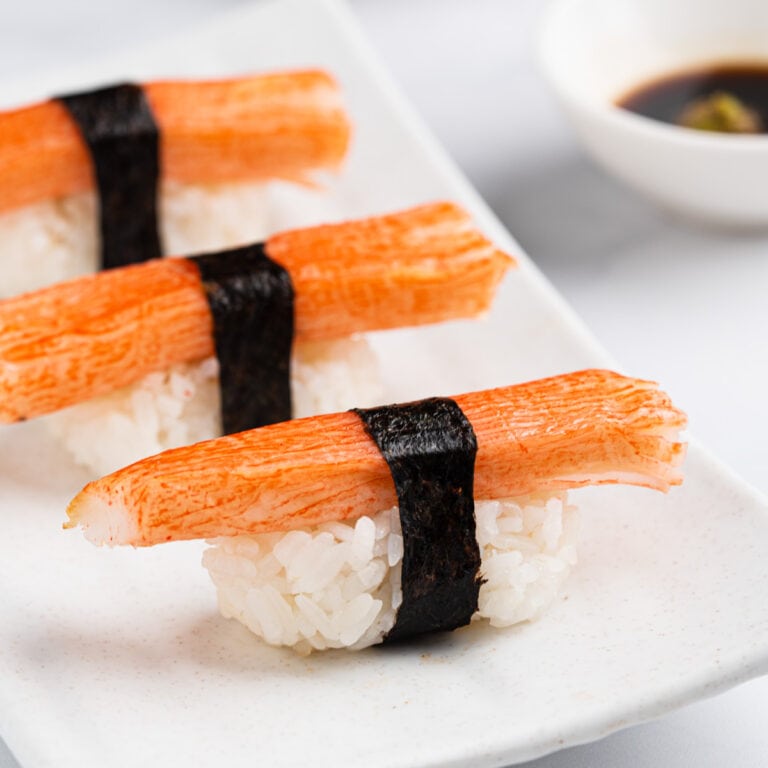
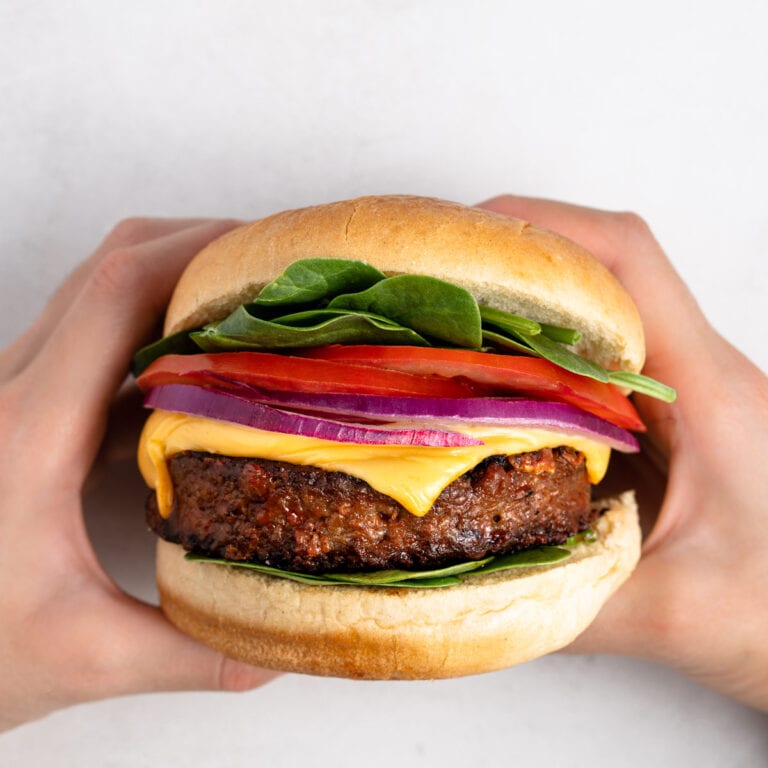
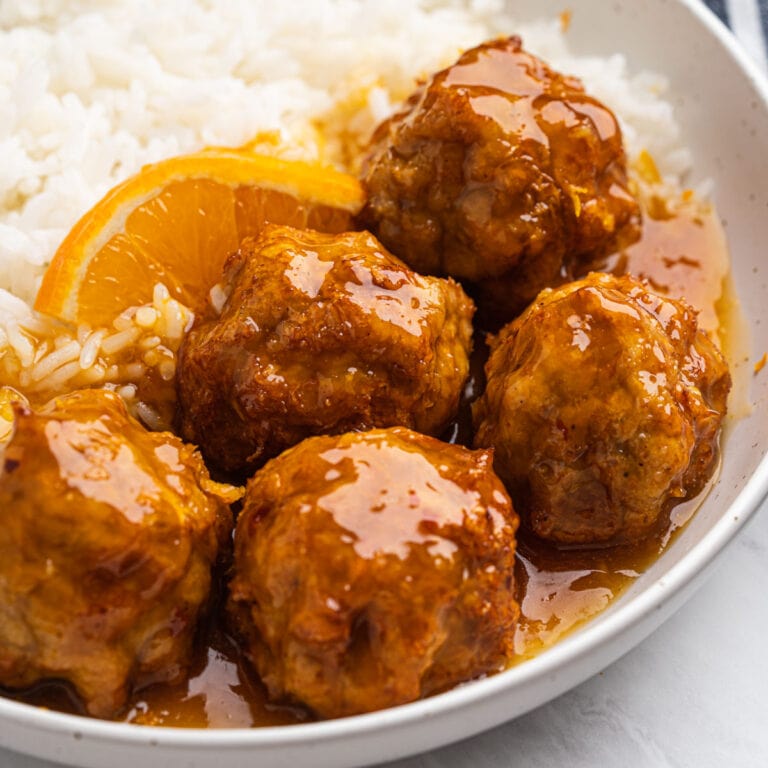

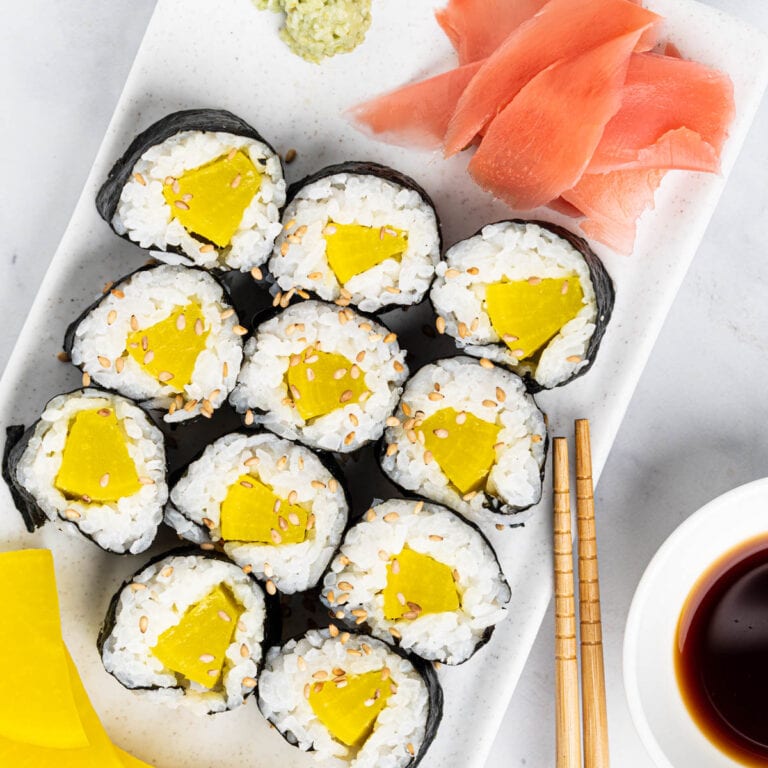
These are so pretty and equally delicious! So happy I can make these at home. Sushi is so expensive at restaurants!
Love sushi, and now we can make this at home!
wow, I love how colorful they look! I’ve never tried sushi before, but this recipe is making me excited to try it.
I love this type of sushi. Thank you for the tip on forming the boat and how to make it adhere to the nori.